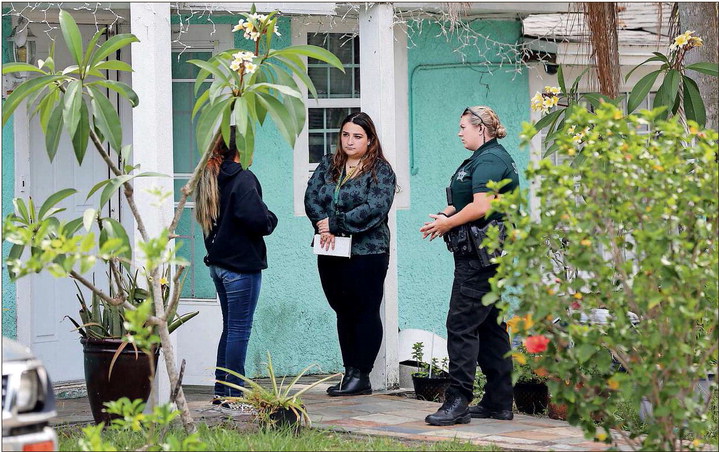By Jack Evans, Tampa Bay Times
Cheryl Gimenez drives a standard-issue Chevy Tahoe: Lights on top, computer mounted in the cab, plexiglass barrier between front and back seats, “Sheriff Pinellas County” emblazoned on the side. A pair of rubber ducks — one styled as a cop, the other as a firefighter — sits on the dashboard.
The quirk is who’s in the passenger seat. Gimenez’s partner, Brittany DeFiore, is a social worker who joined the agency’s mental health unit after Sheriff Bob Gualtieri decided to expand it last year. Gimenez, who became a deputy after five years as a 911 dispatcher, wears a uniform and a body camera and carries a firearm. DeFiore, who said she often worked with people with a psychosis in her last job, wears plainclothes and a lanyard around her neck.
Most days, they crisscross a chunk of north Pinellas County, carved out for the expanded unit’s pilot period, as they respond to 911 calls related to mental health or substance use, or knock on doors to follow up on cases deputies marked as mental health-related.
A call on this Tuesday was familiar to both of them.
An 11-year-old girl had told her therapist she felt suicidal, and the therapist phoned for help.
Clearwater police already were responding, but Gimenez and DeFiore wanted to cut in. They had helped the same girl through a crisis last week — she hadn’t had to be hospitalized. Gimenez had the therapist’s phone number. They had a wider set of tools than did the patrol officers, and if they did need to take the girl to the hospital, as she was requesting, she would at least know the people with her.
Gimenez called her boss, who also was in the area, to explain the situation and why they would intervene.
“She’s one of ours,” Gimenez said.
The mental health unit has existed in various forms for nearly five years, but the expanded and overhauled version that launched this year coincides with changes in cities and counties across the country. Many communities are reckoning with the often ineffective and sometimes deadly results of using law enforcement officers as first responders to mental health crises.
In St. Petersburg, another team established this year comes at similar issues with a different approach: There, unarmed, civilian social workers have begun responding to some calls without police.
The two teams share a core philosophy. Social workers and mental health professionals, equipped with years of education and experience, know how to help people in crisis; law enforcement officers may get 40 hours of training on the subject, but their options in practice often boil down to extremes: arrest, hospitalization or nothing at all.
The St. Petersburg team gets city funding through the Police Department and initially worked alongside officers. Gualtieri, though, doesn’t envision a version of his team in which the social workers — who are Sheriff’s Office employees — respond alone.
“We’re in the mental health business,” Gualtieri said. “Should we be? I don’t know. … But we need to be, and we’re going to be, until somebody else comes in and picks it up.”
The dichotomy puts Pinellas County in an intriguing position: In areas just a few miles apart, residents will be able to see what happens when the role of police in mental health crises is reformed, and what happens when they’re taken out of the equation altogether.
“There’s only so much (law enforcement) can offer,” said Travis Atchison, who runs the St. Petersburg effort. “I tell my team, you’re agents of change.”
The past year marked a turning point in the knotted story of policing and mental health. But in the late 1980s, developments in American cities more than 2,000 miles apart charted separate courses that would ultimately lead to this moment.
In 1987, police fatally shot 27-year-old Joseph Dewayne Robinson outside his mother’s house in Memphis, Tenn. Robinson had a history of mental illness and drug addiction, and his mother told 911 dispatchers that her son had been cutting himself and threatening others. Robinson’s death was no outlier: In the years preceding it, newspapers later reported, Memphis police had killed an average of seven people with mental illnesses every year.
In the aftermath of the killing, police, academics and community organizers collaborated on a crisis intervention team, a group of officers who aimed to reduce the department’s use of force and the rate at which it was jailing people with mental illnesses.
Around the same time, in 1989, the White Bird Clinic in Eugene, Ore., launched a program called Crisis Assistance Helping Out on the Streets. According to the clinic’s website, the program was envisioned as a “community policing initiative,” and it also uses the term “crisis intervention” to describe itself. But it bypassed police involvement, instead sending medics and mental health professionals to 911 calls about suicide threats, substance abuse and interpersonal conflicts.
Over the next 30 years, law enforcement agencies across the U.S. adopted the Memphis model. A 2019 research review found that the training improves officers’ satisfaction, reduces stigma around mental illness and may help in diverting people to psychiatric facilities rather than to jails.
The evidence doesn’t show that officers with crisis intervention training use force any less often than those without it, though.
The Treatment Advocacy Center, a nonprofit that focuses on mental illnesses such as bipolar disorder and schizophrenia, has estimated that people with untreated serious mental illnesses are 16 times more likely to be killed by law enforcement compared to the general population, and that they’re 10 times more likely to wind up in jail or prison than a hospital. Last year, it gave Florida’s involuntary mental health treatment law, the Baker Act, a “D” grade, one of the worst in the nation.
“Fifty years of failed mental health policy in this country has made law enforcement our de-facto mental health crisis response,” said Jeffrey Melada, the center’s communications director. “We’ve foisted this problem on them because we’ve refused to address it as a society.”
Despite the proliferation of crisis intervention training and an increased awareness of how mental health and policing are tied together, Gualtieri said, significant training on the subject still isn’t baked into the profession.
“What ends up happening,” he said in a recent interview, “is that cops solve the problem by removing the problem from the situation.
“People either get arrested or they get Baker Acted. You shouldn’t be criminalizing mental health issues. But again, at 3 o’clock in the morning, when you don’t have anything else, what do you do?”
While law enforcement struggled to adjust to the challenges of mental illness, the crisis program in Oregon thrived outside the national spotlight. In 2017, according to the White Bird Clinic, the program saved the city of Eugene an estimated $12 million and responded to nearly one of every five 911 calls. Though critics often have raised safety concerns around similar programs, police were called as backup in just 150 of the 24,000 calls the program answered in 2019.
Philip Yanos, a professor of psychology at the John Jay College of Criminal Justice, said the successes and shortcomings of crisis intervention training show that it’s “the baseline minimum” that agencies should offer. Adaptations now emerging have been slower to catch on, in part because of a lack of peer-reviewed research, he said.
Things have moved fast in the last year, though, he said. He traces the shift to the March 2020 death of Daniel Prude in Rochester, N.Y.: Prude was apparently delirious when police responded to calls about him behaving erratically; he was handcuffed when they covered his head with a hood and pressed his face into the pavement, and he stopped breathing minutes later. (A grand jury this year declined to bring charges against the officers involved.)
“If you were talking to me this time last year, we would be talking about (crisis intervention training) and co-response, and co-response would’ve seemed like a real progressive approach,” Yanos said recently. “Now the climate is favoring a non-police crisis response.”
In either case, he said, cities and counties have to proceed without an abundance of evidence, knowing they’ll probably have to make adjustments as they go. Melada said it’s impossible to unilaterally deem one model better than another, because different communities need different things. Even the Oregon model can’t be exactly replicated elsewhere, because of specific demographics, needs and mental health resources.
But “if people are dying,” Yanos said, “you don’t wait.”
Those deaths dominated the news cycles and social movements of 2020, in ways that often raised questions about the fundamentals of policing.
Mental illness didn’t play into the killings of George Floyd or Rayshard Brooks, but some people wondered: Should police have even responded in those cases — to a fake $20 bill, to a man sleeping in his car? Calls to reduce and redirect police funding were condemned by law enforcement leaders and unions, but there was a sliver of common ground: Activists wanted crisis response options that didn’t involve guns or handcuffs, and officers knew they weren’t equipped for mental health calls.
And the toll of deadly encounters continued, both nationally and in Tampa Bay.
In June 2020, Pasco County Sheriff’s deputies responded to a call about a Port Richey woman who was armed and suicidal. The woman, Bonnie Figueroa-Ortiz, slipped away from her home while deputies were outside. When deputies found her the next morning, she ran, holding a gun, and soon encountered another deputy, who fatally shot her. Prosecutors declined to file charges, and a state investigation cleared him of wrongdoing.
And in August that year, a St. Petersburg officer fatally shot 55-year-old Jeffrey Haarsma outside his home on Fourth Street N. Police had encountered Haarsma dozens of times and had documented his mental health struggles. When an officer tried to detain him during a petty theft investigation, Haarsma began choking her, and she shot him. A
subsequent investigation found that the shooting was justified, but that officers had erred in several ways leading up to the incident, including failing to consider Haarsma’s history of mental illness.
Protest marchers in St. Petersburg had by then been demonstrating for weeks, as part of the nationwide uprising that followed the murder of Floyd by a Minneapolis police officer. On July 3, St. Pete protesters released a list of demands. Among them: The city should create teams, staffed by non-police experts, to respond to crises involving mental health, drug overdoses and other issues.
Police Chief Anthony Holloway announced six days later that the city would send social workers, instead of police, to some calls. “Our citizens are asking for change,” he said. However, Holloway later denied that protesters’ demands had prompted the creation of what would become St. Petersburg’s Community Assistance and Life Liaison, or CALL, program.
Jabaar Edmond, a community organizer active in the protest marches, said he didn’t need city officials to connect the community assistance team to the marches — the victory was that the team existed at all.
“It doesn’t have to be because of our marching,” he said. “It doesn’t have to be because someone dies. It doesn’t have to be because, you know, the Times is doing a story. Let it be for whatever reason.”
The St. Petersburg City Council soon agreed to spend $850,000 of its 2020-21 budget on the program. In January, it approved a contract with Clearwater-based Gulf Coast Jewish Family and Community Services, which hired the team led by Atchison. It includes three clinical supervisors and a dozen “navigators,” who would answer calls ranging from mental health crises to homelessness, truancy or neighbor disputes — all of which, they found, often were underpinned by mental health issues.
Navigators responded to calls alongside officers in the first weeks after the team’s February launch. In those early days, Atchison said, he found it helpful to work with officers who knew the territory and, in some cases, the high-volume callers, who might make 20 calls to 911 in a short period.
Atchison has a wide-ranging counseling background; he does child therapy on the side and is pursuing a doctorate. His navigator on a recent day in the field, Katelyn DiRaimo, graduated college last year with a criminal justice degree and worked at a domestic violence shelter before joining Atchison’s team. They wear T-shirts or polos, and khakis.
Atchison drives a black Toyota Camry that has, by his account, seen more than you care to know. Back and forth across St. Petersburg, he bumps George Jones and old-school hip, rolling the windows down to puff on Marlboro Blacks. Few would mistake them for law enforcement.
Still, Atchison said, it’s key to show people that his team has different tools and goals than police. Many of those they encounter expect to be hospitalized, or even arrested.
Atchison wants to avoid those experiences, which can create more trauma, he said. He wants people to maintain agency over their lives, even when they need help.
He said he’s quick to say: “I’m here to hear you out.”
What happened locally also was happening across the country. Programs emerged in Denver and Portland, Oakland and San Francisco and Los Angeles. Nashville’s police department started a co-response program. Officials in Hartford, Conn., announced a plan for a civilian crisis response team.
In Pinellas County, Gualtieri’s effort coincided with the national wave, but unlike the changes in many places, the sheriff was overhauling an existing unit rather than creating a new one.
Gualtieri realized around 2013, he said, that “the people who are called upon the most to deal with people in crisis and deal with people with mental health issues are those that are least qualified to deal with them — and that’s law enforcement.”
In 2016, his office launched an early iteration of the mental health unit. But it had trouble finding its footing: A pilot in the Lealman area, where a four-person unit tried to respond to calls and do follow-ups, yielded “more error than trial,” Gualtieri said. A later version of the team followed up on calls that responding deputies marked as mental health-related. But the process was inconsistent, Gualtieri said, and the staff turned over too often.
He decided last year that the team would have to respond to calls and conduct follow-ups, but also act as a hub: to connect clients and their families to different healthcare providers while sharing information among providers.
“Now we can coordinate with the services, the agency they’re seeing and say, ‘Listen, just last night this client was having delusions of x, y and z, but they didn’t meet Baker Act criteria,’ ” said Sgt. Joleen Bowman, who oversees the unit. “Well, now they have that knowledge … to help with their treatment plan and move forward.”
The mental health unit consists of six deputies, two Clearwater officers and eight crisis response specialists, plus Bowman and a clinical supervisor. They work across a chunk of northern Pinellas County that includes part of Clearwater and spans State Road 580 to Belleair Road.
“Twenty-seven years ago, you had mental health out there, it was: You took the report, you made an arrest, or maybe you handed them paperwork — here’s a referral, best of luck,” said Maj. Dennis Komar, who oversees the Sheriff’s Office’s patrol operations bureau. “Times have changed.”
To Gimenez, the mental health unit deputy, a more nuanced approach to mental health issues was a natural part of the job. Before becoming a deputy, she spent 12 hours a day as a dispatcher, keeping calm while guiding callers through their most panicked moments.
The skills she learned in that job — to be patient, to listen carefully to discern what people really need — have served her well in her current role, she said, where she aims to use handcuffs and the Baker Act as little as possible.
“You want to give people their power back,” she said.
In February, the first full month for the expanded mental health unit, teams encountered 161 people, most often during welfare checks or calls about “emotional distress.” They used the Baker Act 33 times and tallied 53 cases in which they “diverted” people away from it. More than 70 agreed to be connected to mental health services. The Sheriff’s Office did not supply data for recent months, but, Gualtieri said, the numbers he’d seen for March and April were similar.
Gualtieri won’t know enough to make a decision on the unit’s future until at least the six-month mark, he said.
“But I like what I’m seeing,” he said. “I think it’s making a difference. I know we’re making better decisions.”
From its launch date on Feb. 2 through May 23, the St. Petersburg crisis team tallied more than 1,500 contacts. More than 300 of those were referrals from officers who encountered people they thought would benefit from the team’s expertise, according to the St. Petersburg Police Department, which tracks the data.
More than half the calls they responded to involved mental health problems or suicide threats; about a quarter were about panhandlers, and the rest were a mixture of neighbor disputes, youth issues and substance abuse. None turned violent.
The St. Petersburg team’s pilot period ends with the city’s fiscal year at the end of September, but Holloway said in a forum earlier this month that he plans to ask for more funding.
“We’re just waiting now for the City Council approval to continue, maybe multi-year,” he said. “We want to move forward with this program.”
Should the program keep going, the people getting the team’s services a year from now may be a totally different group from today’s clients. The team may work with people over a span of two days to two months, Atchison said, but they won’t become permanent case managers. Their goal is to act as a bridge to a more stable place, where someone has medication, a therapist, regular food and housing — what they need to live.
“We want to restore individuals back to their level of functioning prior to crisis,” Atchison said one recent morning, as he and DiRaimo headed to a follow-up visit with a man who had recently been examined under the Baker Act.
The days after people are released from the hospital can be the most challenging. They may have a fresh diagnosis and prescription but typically have no more support than before. That can leave them vulnerable or overwhelmed, Atchison noted.
“Hell,” he added, “99 percent of the time, discharge paperwork’s left in the car.”
He and DiRaimo found 44-year-old Jason Sharp sitting in a camp chair outside his second-floor apartment. DiRaimo climbed the stairs and crouched in front of him, and they quickly settled into an easy conversation.
“Are you feeling better than you were when I saw you last time?” she asked.
“A little bit,” he said.
He talked about his financial struggles — he’d worked in landscaping, he said, but his driver’s license was suspended, and it was hard to keep a job without one. DiRaimo said she’d researched his neighborhood and found a church and a library nearby, and she wondered if he’d find either helpful. If he could find a job but needed a ride, she’d help with that, too.
Sharp said he’d been subjected to the Baker Act before, a couple of years earlier, and though he was released with a stack of phone numbers for community resources, his depression made the task of calling them overwhelming.
He looked at DiRaimo, a slight smile hovering on his face. He seemed surprised, or relieved.
“I honestly thought I’d never see you guys again,” he said.
View the original story here.






